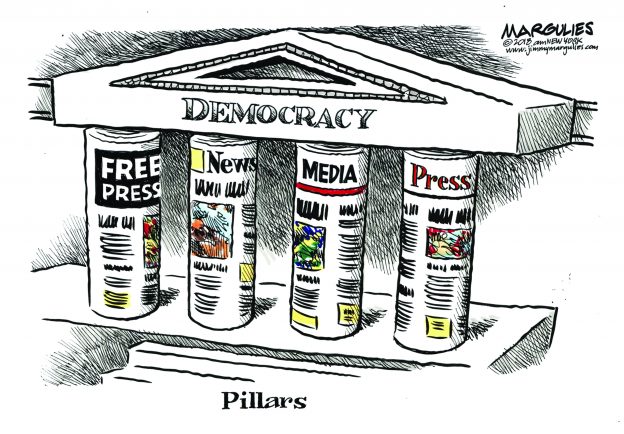Barbara Sutliff is a book and magazine designer and art director who recently worked on an editorial cartoon book for the American Association of Editorial Cartoonists (AAEC). On a tip from her husband, cartoonist Joe Sutliff, Barbara and I got together for an informal email interview.
I heard that local editorial cartoonist Matt Wueker was doing a book for a Billy Ireland Cartoon Library and Museum exhibit in Columbus, OH? They have an editorial cartoon show that's only up for another month. Is that what it's for?
 Yes it is based on the show, the AAEC has their conference there this coming weekend. The AAEC will have the book for sale. It was a very small print run for the conference, and the association plans to show it to some of the large book publishers that will be there in hopes of interesting them in publishing it on a larger scale, perhaps even an expanded version.
Yes it is based on the show, the AAEC has their conference there this coming weekend. The AAEC will have the book for sale. It was a very small print run for the conference, and the association plans to show it to some of the large book publishers that will be there in hopes of interesting them in publishing it on a larger scale, perhaps even an expanded version.
What's the title, and who's the author?
The title is Front Lines: Political Cartooning and the Battle for Freedom of Speech by The Association of American Editorial Cartoonists. This is similar to the title of the exhibition, which was Front Line: Editorial Cartoonists and the First Amendment.
The editor of the book is Matt Wuerker, award winning political cartoonist from Politico and former president of the AAEC, and a friend of ours (Joe and I).
How did you get involved? What did you do for them?
Matt saw Joe at an event and mentioned the project and asked whether I might be interested in designing the book. We talked and I was very excited to work on such a fun and important project. Matt was terrific to work with. After hearing his ideas for the look of the book, we talked back and forth as I showed different options for the chapter design treatments, Once chosen, it was a really smooth collaboration—Matt was just finishing up getting the essays edited and finalized, while collecting hi-res versions of the many cartoons that he was organizing to go with each chapter/essay.
 |
| Liz Donnelly drawing and table of contents |
In the meantime I roughed out the book to get a firmer idea on page count for each chapter and for the overall book, including many cartoons chosen to go with each chapter. As I have designed and produced hundreds of publications over the years—this project was a great fit—Matt and I had a smooth back and forth with emails including pdfs of pages with notes attached with my questions, suggestions as well as his corrections, answers and suggestions. We also had periodic phone calls to go over the status chapter by chapter. I worked in InDesign and sent pdf proofs which as I mentioned, we added electronic sticky notes to for specific questions and to provide me with credit info for each piece etc. When everything was approved I made hi-res print quality pdfs for the printer. Matt already had this idea in mind for the cover—he provided my with his mockup in InDesign which I tweaked (I am a stickler when it comes to kerning and typography and Matt was thrilled with that attention to detail on my part!) It was a great experience, I loved designing and producing the book. Matt just told me he is putting a printed copy in the mail for me and I am so glad to hear that he is very happy with the printed edition.
How many images are in the book? Is everything from the exhibit in it? Was there anything tricky or difficult about the layout?
I counted 100 cartoons in the book not counting Matt’s cover cartoon. It also has essays by Joel Pett, Lucy Caswell, Roslyn Mazer, Rob Rogers, Ann Telnaes and Matt.
I didn’t know whether the book included everything from the exhibit, since I didn't see the show, but Matt says, "No.... And many of the cartoons in the book are not in the show. It's by no means a catalog of the show. We just used that as a jumping off point.”
The tricky thing for me was incorporating many horizontal cartoons into the design without having the option of going across the gutter of a perfect bound book like I might when designing with photographs, which can have impact across a spread—but obviously that doesn’t work with cartoons with words. I created a grid with an appropriate width for type, on a square page which allowed for a narrow outside column to be used for pull quotes and to have the flexibility to use the full width including the narrow column for cartoons to jut out beyond the type column. It works as many of the cartoons are horizontal and allows for variety in the design of each spread with varying sized art along with the text and pull quotes drawing the reader to important ideas from the chapter and that act as design elements on the page as well. I guess the other tricky thing that comes to mind is that the chapters were mostly cartoons with an essay flowing through them as opposed to a text-heavy book punctuated by spot illustrations. So the challenge was to keep the continuity of the words flowing around the cartoons which meant jumping the words around a spread or two of just art so that the cartoons and words complemented one another.







